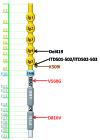Preclinical human models and emerging therapeutics for advanced systemic mastocytosis
- PMID: 29976735
- PMCID: PMC6278969
- DOI: 10.3324/haematol.2018.195867
Preclinical human models and emerging therapeutics for advanced systemic mastocytosis
Abstract
Mastocytosis is a term used to denote a group of rare diseases characterized by an abnormal accumulation of neoplastic mast cells in various tissues and organs. In most patients with systemic mastocytosis, the neoplastic cells carry activating mutations in KIT Progress in mastocytosis research has long been hindered by the lack of suitable in vitro models, such as permanent human mast cell lines. In fact, only a few human mast cell lines are available to date: HMC-1, LAD1/2, LUVA, ROSA and MCPV-1. The HMC-1 and LAD1/2 cell lines were derived from patients with mast cell leukemia. By contrast, the more recently established LUVA, ROSA and MCPV-1 cell lines were derived from CD34+ cells of non-mastocytosis donors. While some of these cell lines (LAD1/2, LUVA, ROSAKIT WT and MCPV-1) do not harbor KIT mutations, HMC-1 and ROSAKIT D816V cells exhibit activating KIT mutations found in mastocytosis and have thus been used to study disease pathogenesis. In addition, these cell lines are increasingly employed to validate new therapeutic targets and to screen for effects of new targeted drugs. Recently, the ROSAKIT D816V subclone has been successfully used to generate a unique in vivo model of advanced mastocytosis by injection into immunocompromised mice. Such a model may allow in vivo validation of data obtained in vitro with targeted drugs directed against mastocytosis. In this review, we discuss the major characteristics of all available human mast cell lines, with particular emphasis on the use of HMC-1 and ROSAKIT D816V cells in preclinical therapeutic research in mastocytosis.
Copyright© 2018 Ferrata Storti Foundation.
Figures




Similar articles
-
The KIT and PDGFRA switch-control inhibitor DCC-2618 blocks growth and survival of multiple neoplastic cell types in advanced mastocytosis.Haematologica. 2018 May;103(5):799-809. doi: 10.3324/haematol.2017.179895. Epub 2018 Feb 8. Haematologica. 2018. PMID: 29439183 Free PMC article.
-
A new humanized in vivo model of KIT D816V+ advanced systemic mastocytosis monitored using a secreted luciferase.Oncotarget. 2016 Dec 13;7(50):82985-83000. doi: 10.18632/oncotarget.12824. Oncotarget. 2016. PMID: 27783996 Free PMC article.
-
CRISPR/Cas9-engineering of HMC-1.2 cells renders a human mast cell line with a single D816V-KIT mutation: An improved preclinical model for research on mastocytosis.Front Immunol. 2023 Mar 21;14:1078958. doi: 10.3389/fimmu.2023.1078958. eCollection 2023. Front Immunol. 2023. PMID: 37025992 Free PMC article.
-
Advanced systemic mastocytosis: from molecular and genetic progress to clinical practice.Haematologica. 2016 Oct;101(10):1133-1143. doi: 10.3324/haematol.2016.146563. Haematologica. 2016. PMID: 27694501 Review.
-
Clonality and molecular pathogenesis of mastocytosis.Acta Haematol. 2005;114(1):61-9. doi: 10.1159/000085563. Acta Haematol. 2005. PMID: 15995326 Review.
Cited by
-
Metformin: A potential adjunct for treatment of systemic mastocytosis.J Allergy Clin Immunol Glob. 2023 Nov 7;3(1):100186. doi: 10.1016/j.jacig.2023.100186. eCollection 2024 Feb. J Allergy Clin Immunol Glob. 2023. PMID: 38089917 Free PMC article.
-
Drug delivery targets and strategies to address mast cell diseases.Expert Opin Drug Deliv. 2023 Feb;20(2):205-222. doi: 10.1080/17425247.2023.2166926. Epub 2023 Jan 29. Expert Opin Drug Deliv. 2023. PMID: 36629456 Free PMC article. Review.
-
Recent advances in the understanding and therapeutic management of mastocytosis.F1000Res. 2019 Nov 22;8:F1000 Faculty Rev-1961. doi: 10.12688/f1000research.19463.1. eCollection 2019. F1000Res. 2019. PMID: 31824655 Free PMC article. Review.
-
Impact of Echinococcus granulosus Cyst Fluid on the Phenotypic Dynamics and Degranulation of RBL-2H3 Mast Cells.J Inflamm Res. 2025 Jul 24;18:9837-9848. doi: 10.2147/JIR.S522640. eCollection 2025. J Inflamm Res. 2025. PMID: 40727458 Free PMC article.
-
Mutational Landscape of KIT Proto-Oncogene Coding Sequence in 62 Canine Cutaneous and Subcutaneous Mast Cell Tumors.Vet Sci. 2024 Nov 25;11(12):593. doi: 10.3390/vetsci11120593. Vet Sci. 2024. PMID: 39728933 Free PMC article.
References
-
- DeBruin EJ, Gold M, Lo BC, et al. Mast cells in human health and disease. Methods Mol Biol. 2015;1220:93–119. - PubMed
-
- Kirshenbaum AS, Metcalfe DD. Growth of human mast cells from bone marrow and peripheral blood-derived CD34+ pluripotent progenitor cells. Methods Mol Biol. 2006;315:105–112. - PubMed
-
- Galli SJ, Tsai M, Wershil BK, Tam SY, Costa JJ. Regulation of mouse and human mast cell development, survival and function by stem cell factor, the ligand for the c-kit receptor. Int Arch Allergy Immunol. 1995;107(1–3):51–53. - PubMed
-
- Brown JM, Wilson TM, Metcalfe DD. The mast cell and allergic diseases: role in pathogenesis and implications for therapy. Clin Exp Allergy. 2008;38(1):4–18. - PubMed
Publication types
MeSH terms
LinkOut - more resources
Full Text Sources
Other Literature Sources

